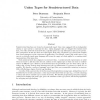Free Online Productivity Tools
i2Speak
i2Symbol
i2OCR
iTex2Img
iWeb2Print
iWeb2Shot
i2Type
iPdf2Split
iPdf2Merge
i2Bopomofo
i2Arabic
i2Style
i2Image
i2PDF
iLatex2Rtf
Sci2ools
DBPL
1999
Springer
1999
Springer
Union Types for Semistructured Data
Semistructured databases are treated as dynamically typed: they come equipped with no independent schema or type system to constrain the data. Query languages that are designed for semistructured data, even when used with structured data, typically ignore any type information that may be present. The consequences of this are what one would expect from using a dynamic type system with complex data: fewer guarantees on the correctness of applications. For example, a query that would cause a type error in a statically typed query language will return the empty set when applied to a semistructured representation of the same data. Much semistructured data originates in structured data. A semistructured representation is useful when one wants to add data that does not conform to the original type or when one wants to combine sources of di erent types. However, the deviations from the prescribed types are often minor, and we believe that a better strategy than throwing away all type informat...
| Added | 04 Aug 2010 |
| Updated | 04 Aug 2010 |
| Type | Conference |
| Year | 1999 |
| Where | DBPL |
| Authors | Peter Buneman, Benjamin C. Pierce |
Comments (0)

